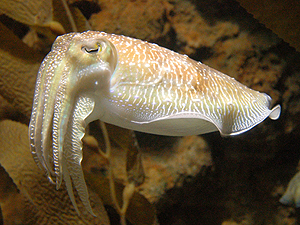
Common cuttlefish (Sepia officinalis). Source: Wikipedia.
 Common cuttlefish (Sepia officinalis). Source: Wikipedia. |
Cuttlefish are cephalopods, which are also found in the North Sea. On the beach, though, they are rarely found, but more often their shells, which are called cuttlebones. Those shells are much larger than those of a squid and, made of porous material, they also improve the Sepia's buoyancy. Cuttlebones are also used in bird cages, for the birds to whet their beaks.
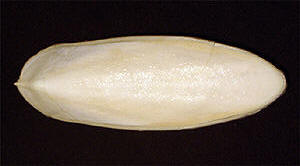 A cuttlebone, the cuttlefish's internal shell. Source: Wikipedia. |
Cuttlefish themselves live near the ocean floor, where they hide between see weed and wait for prey. In the North Sea and in the Mediterranean, there is the common cuttlefish (Sepia officinalis). In the Red Sea and in the western Indian Ocean there is also the Pharaoh cuttlefish (Sepia pharaonis). The largest species is the giant cuttlefish (Sepia apama), which lives around southern Australia. It grows up to a maximal size of 50 centimetres (mantle and cuttlebone), growing to one metre and a half including the tentacles. As well as among the squids, generally the size of the mantle is used for determination purposes in cuttlefish, as the tentacles are very flexible and thus measuring them is usually unspecific.
The flamboyant cuttlefish (for example Metasepia pfefferi) from the waters of Indonesia and the Philippines is true to its name; compared to a common cuttlefish it is really flamboyant with its colourful pattern of red, yellow and brown.
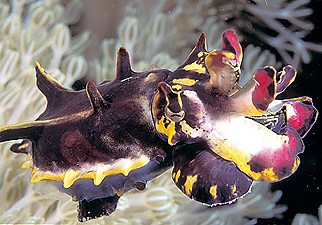 Flamboyant Cuttlefish (Metasepia pfefferi). Source: Jeff Rosenfeld. |
Systematically, as already mentioned in the beginning, cuttlefish belong among the ten-arm cephalopods (Decapodiformes). Sometimes that is hard to see, because sepias keep their two long tentacles hidden inside the eight short ones, when they are not used. Other than its nearest relatives, the squids, Sepia is a lurking predator: When it observes a prey, it undulates its lateral fin fringe and catches the prey with the two long tentacles. This motion usually is so fast that it is hardly seen with the bare eye. Cuttlefish, like all cephalopods, mainly feed on crabs and other molluscs. They as well inject saliva fluid into the prey's organism to paralyse it.
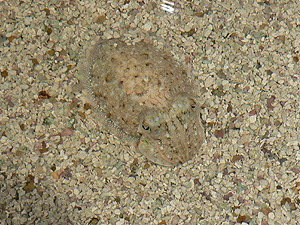 Cuttlefish camouflaged on the ocean floor. Source: Wikipedia. |
As cuttlefish mainly orient themselves by sight, they have very good and also very large eyes. In contrary to squids and octopuses, however, cuttlefish have got a characteristic w-shaped pupil, so when they have their eyes almost closed, they can actually see from two pupils.
Cuttlefish can be distinguished from the relatives, the squids, in that they have a much larger shell, as already mentioned above. Also the form of their body is very different. Whereas squids have a torpedo-shaped body, because they are fast swimmers, cuttlefish have a broadened and flattened body suited to their life as a lurking predator. Besides, cuttlefish often hide on the ground, or in it, which is also much easier with a flat body.
In contrary to a squid's tail fins, cuttlefish have got a fin fringe running around all of the body side. A cuttlefish moves by undulating that fringe. Additionally, the cuttlefish can use the "rocket" propulsion typical of all cephalopods: Water is pressed from the pallial (mantle) cavity through the siphon, which is also used to direct the propulsion. So the cuttlefish is driven backward, which it uses mainly to evade an enemy, especially on short distances.
|
Discovery News: Cuttlefish - Chameleons of the Sea. Source: YouTube. |
Instead of fleeing with high speed, cuttlefish tend more to use their abilities of camouflage. With their flat body, they can hide in a flash by disappearing in the ground. Besides, they have the ability to change their colour by using pigment cells (chromatophores) in their skin. So they can well adapt their appearance to their environment, also by changing the shape of their body or by using their arms to appear like a water plant.
The colour of a cuttlefish is of importance not only for its camouflage. It also displays the cuttlefish's mood. Especially during mating, but also for communication with other cuttlefish, the plays of colour can be observed.
Especially on the North Sea coast of Germany and the Netherlands each year hundreds of cuttlefish meet to mate. The males signal to the females their willingness to mate by raising two arms. If the other cuttlefish also raises two arms, it is a male and must be dealt with accordingly. Both males then begin to duel with bright colour plays, until one of both competitors leaves the field. The bright zebra colour, in which a cuttlefish is often displayed, signals willingness to mate to a female cuttlefish. What is very fascinating: While this signals willingness to mate to a female, it also signals willingness to fight to another male cuttlefish!
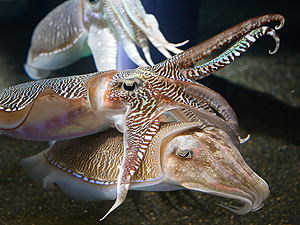 Mating cuttlefish in the Georgia Aquarium. Source: Wikipedia. |
In some Sepia species, during the period of mating, there are also fights between males, during which they try to push the adversary away or to turn him on the back to show their strength. Sometimes the adversary is also strongly bitten, but usually the cuttlefish in the inferior position will wisely withdraw ejecting ink.
Cuttlefish mating time in the North Sea happens in spring, when the coastal waters are warmer than 10° centigrade. Around Easter, a large number of cuttlefish appears to mate in the Oosterschelde, an estuary at the Dutch North Sea coast. The males fight their duels for mating partners, and a short while later, males and females mate, entangling their short tentacles.
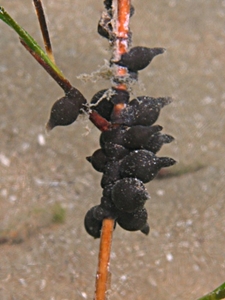 Egg capsules of a common cuttlefish (Sepia of- ficinalis). Picture: Roberto Pillon. |
The male now transfers a sperm packet (a spermatophore) with a specially modified one of its eight short tentacles. During mating, cuttlefish display an interesting form of competition: Some species flush the female's sperm receptacle with a squirt of water; others remove other males' sperm using a special spoon-shaped arm. Taking into account that the male dies after the process of mating and the female usually shortly after laying eggs, this appears a feasible strategy.
In general shortly after mating, the female cuttlefish will begin to lay eggs. Sometimes the male guards it, to be sure, only the eggs fertilised by him are laid. A cuttlefish's eggs are kept in a sturdy, pillow-shaped capsule, which in some species is coloured with ink. The batch of eggs is left to its own devices, until, for example, the fully developed young of Sepia pharaonis, hatch 19 days later at a size of about ten millimetres.
Cuttlefish of all cephalopods are most of use to man. The cuttlebone is used as a beak-whetting-stone and calcium resource for birds in cages. Cuttlefish's ink in diluted stage has been of use as painting colour. We also know of the "sepia-brown" colours in early photography. Today cuttlefish ink's main use, apart from the cosmetics industry, is for food: The dark colour of spaghetti "Seppia" comes from cuttlefish ink mixed to the spaghetti dough. The main use of cuttlefish to man, though, is to fishery. Cuttlefish are esteemed as a delicacy and fished with nets or speared.